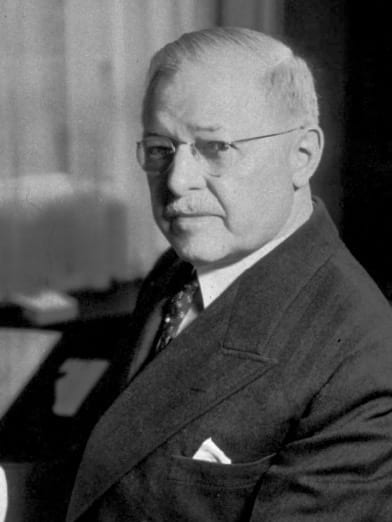Walter Bastedo
Walter Arthur Bastedo (1873 – 1952) was a Canadian-American gastroenterologist and pharmacologist.
Professor Bastedo was a prominent physician, leader, teacher, and researched in the field of gastroenterology and pharmacology. He published renowned descriptions of using insufflation to aid in diagnosis of gastrointestinal diseases.
He is eponymously associated with Bastedo sign (1909) of chronic appendicitis.
Biography
- Born on March 8, 1873 in Ontario, Canada
- 1889 – Emigrated to the United States, and becoming a citizen in 1901
- 1894 – Graduated from the College of Pharmacy of the City of New York (now part of Columbia University)
- 1895 – Lecturer in botany at the New York College of pharmacy and curator of the New York Botanic Garden
- 1899 – Graduated with MD degree from the College of Physicians and Surgeons, Columbia University
- 1902 – Chief of the Gastroenterological Clinic of Vanderbilt Clinic
- 1914-29 – Attending physician at St Luke’s Hospital, New York
- 1915-19 – Member of the Advisory Council of the Department of Health
- 1917 – Assistant Professor of Clinical Medicine at Columbia University
- 1918-19 – Chairman of the Section of Pharmacology and Therapeutic Committee, American Medical Association
- 1919 – President of the American Gastroenterological Association
- 1921 – President of the New York Gastroenterological Association
- 1924 – Fellow of the American College of Physicians
- 1929 – Honorary Doctor of Science degree from Columbia University
- 1934 – Honorary Master of Science degree from Philadelphia College of Pharmacy and Science
- Died on July 20, 1952 in New York, United States
Medical Eponyms
Bastedo sign (1909)
Bastedo described a method of dilating the colon with air and causing acute right lower abdominal pain over McBurney’s point to aid in the diagnosis of chronic appendicitis. His original descriptions were presented to the Medical Society of the County of Richmond (1909), and published in St. Luke’s Hospital Medical and Surgical Reports:
To dilate the colon a soft rubber rectal tube is inserted about twelve inches and air forced through it by means of an atomizer bulb. The introduction of the tube is facilitated if air is forced through it during its passage up the rectum … In the routine examination of digestive patients by colon dilation, I noted, some three years ago, that acute pain or tenderness in the region of McBurney’s point on dilation of the colon regularly meant appendicitis. I have now many cases in which the finding has been proved by operation, and in every case operated upon in which the sign was positive, a diseased appendix has been found. I have a few cases thought to be appendicitis in whic the sign was negative; in some of these from one to three years have passed without any appendix manifestations; in the others operation was performed and the appendix was found normal. In no operation cases with the sign negative was appendicitis found…
Bastedo, 1910: 108-110
In the same paper, Bastedo highlighted that dilation of the colon was also useful in determining rectal and colon obstruction; along with the location of the sigmoid flexure, transverse colon (and the condition of its muscle), cecum, and a tumor or tender spot.
Major Publications
- Bastedo WA. Artificial dilation of stomach and colon as aids in abdominal diagnosis; with a helpful sign in chronic appendicitis. St. Luke’s Hospital Medical and Surgical Reports. 1910; 2: 104-111. [Bastedo sign]
- Bastedo WA. The dilatation test for chronic appendicitis. American Journal Of The Medical Sciences. 1911; 142: 11-14
- Bastedo WA. Materia medica, pharmacology, therapeutics, prescription writing. 1913 [2e 1918]
- Bastedo WA. The Treatment of Chronic Dyspepsia. Medical Clinics of North America. 1938;22(5):1407-1417.
References
Biography
- Walter Arthur Bastedo JAMA. 1952; 150(3): 233.
- Andresen AF. Dr. Walter Arthur Bastedo, 1873-1952. Gastroenterology. 1953; 25(1): 91-92.
- [Walter A. Bastedo] US National Library of Medicine: 101410060
- Bibliography. Bastedo, Walter Arthur. WorldCat Identities
Eponymous terms
- Hertz AF. Bastedo’s sign: A new sign of chronic appendicitis. Lancet 1913; 181(4673): 816-817
- Lichty JA. Chronic Appendicitis. JAMA. 1922; 79(11): 887–893.
- Rastogi V, Singh D, Tekiner H, Ye F, Mazza JJ, Yale SH. Abdominal Physical Signs of Inspection and Medical Eponyms. Clin Med Res. 2019; 17(3-4): 115-126.
- Eponymythology: Appendicitis eponymous signs. LITFL
[cite]
Doctor in Australia. Keen interest in internal medicine, medical education, and medical history.

